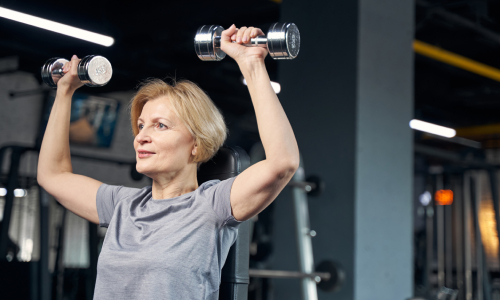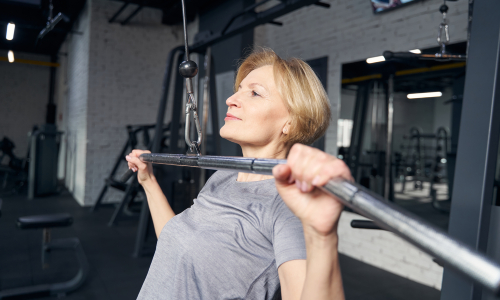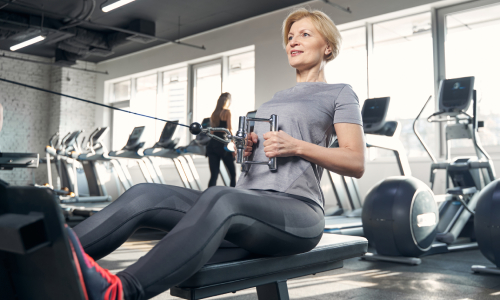How exercise can support you through the menopause
- Overview
Exercise is beneficial for your physical and mental health, no matter what your age – but strength training is especially useful during the menopause and beyond, when the risk of osteoporosis and weight gain is higher.
Building muscle
As you get older, your metabolism tends to slow down – one reason for this is age-related muscle loss (muscle atrophy), due to the body becoming more resistant to normal growth signals.
Muscle burns more calories than fat, so when you don’t preserve muscle, you’re more likely to put on weight – which can lead to forms of arthritis, among other health conditions. However you can help avoid this through physical activity.
Your exercise routine should include a mix of cardio and strength training, which can help to burn fat, even while resting, avoiding menopausal weight gain.
Strengthening bones
Since your estrogen levels drop as a result of the menopause, your risk of osteoporosis increases. This is because estrogen is needed to help produce and protect your bones.
Again, strength training is especially vital – not only does this form of exercise strengthen your muscles, it’s also been shown to increase bone density, helping to reduce the risk of fractures from weak bones.
Exercises that help build muscle and bone density
Below are the different forms exercise you can do – it’s a good idea to include a variety of different types in your exercise routine to reap the benefits each, as well as to keep things interesting.
If you aren’t regularly active, start with two to three days of exercise a week at 30 minutes a session and gradually build your time up to 45–60 minutes per session.
Make sure you warm up and stretch before any form of activity to prepare your body for exercise and reduce the risk of injury.
Strength/resistance training

Strength training includes lifting free weights and using machine weights, while resistance training can include TRX (total body resistance exercise) suspension training, using gym bands, and bodyweight exercises. Read on to learn more about some key strength training exercises and how to perform them.
High-impact cardio
Jogging, dancing, tennis and football are great forms of aerobic exercise for individuals who don’t have osteoporosis or low bone density.
Low-impact cardio
These exercises are ideal for individuals who can’t perform high-impact aerobic activity. Examples include walking, using the cross trainer and stair machine, and aerobics.
Non-weight-baring exercise
Exercises like swimming, cycling, yoga, Pilates and tai chi should be included every week in your exercise routine. These activities won’t strengthen your muscles and bones as quickly as strength training, but they can help with your posture and controlling your pelvic floor, as well as support your mental health.
Strength training exercises
Aim to perform 3–4 sets of 6–12 reps for each exercise. Remember to start with smaller weights and build up the weight gradually over time.
The squat
This is one of the best exercises to build muscle strength and bone density, while increasing mobility in the hips. To perform it, you can load up a bar on your back, or alternatively you can use a TRX or dumbbells.
Lateral pull-down machine

This is an easy pulling exercise to start with that works the lats, biceps and more. To carry out this exercise, you pull the bar or handles to chin height (not pulling too low) and slowly release it back to the top.
Bench press
This can be done with a dumbbells or a bar. Dumbbells help with stability through the joints, while a bar is ideal for all-round strength – so you can start with lighter dumbbells and work up to the bar. This is a very versatile exercise that recruits a lot of muscle and works the opposite muscles used in the lateral pull-down machine.
Leg press
The leg press challenges the true strength of the lower body, while keeping the back safely against the seat. A lot of weight can be used in the leg press, which in turn preserves and strengthens the muscle.
Seated row

This can be done in a rowing machine and then you can advance to dumbbells or a barbell for a bent-over row. Instead of pulling a bar down from overhead you are pulling a weight towards your body from the front, using different muscles and using more day-to-day muscles to strengthen and preserve bone density.
Shoulder press
The action of pushing a weight over your head improves the muscles that help you get objects from the top shelf at home, and push heavy objects overhead. This exercise can be adapted using dumbbells, elastic gym bands, a bar or even using bodyweight in classes like as yoga i.e. the position downward-facing dog.
If you’re new to exercise or need some extra support
There are professionals on hand such as physiotherapists and personal trainers, who can help you with a personalised exercise plan.
These experts can also provide advice on strength training, and put you at ease if you’re stepping into a gym for the first time in a while or even the first time ever.
Related Video: Strong Upper Body with Zahra
This video is part of our on-demand 24/7 content. To view more videos and subscribe to our 24/7 virtual gym click here.
Last updated Thursday 16 March 2023
First published on Friday 16 September 2022

